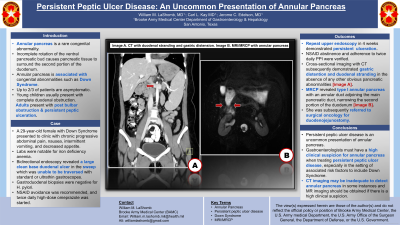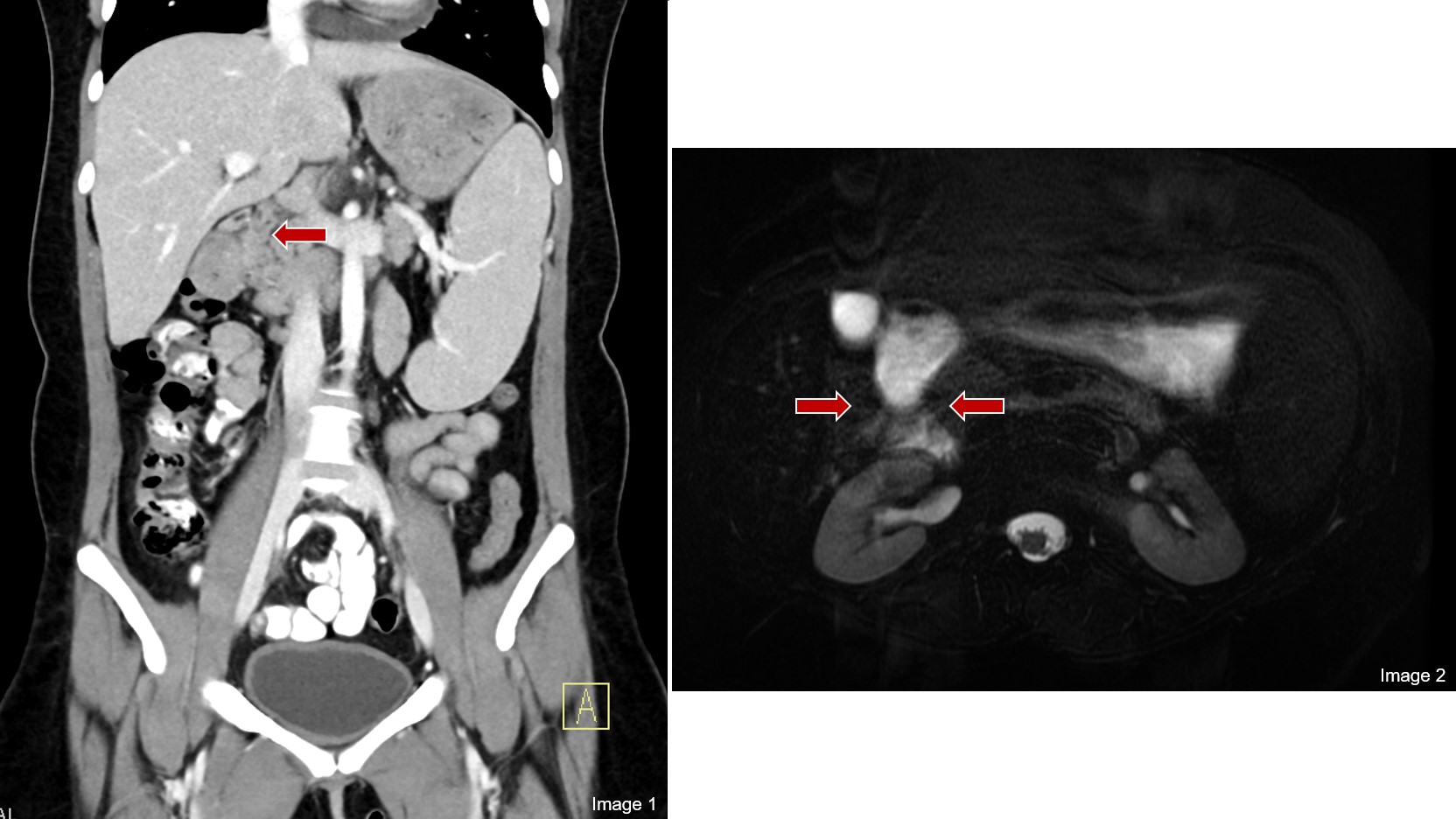Tuesday Poster Session
Category: Biliary/Pancreas
P3509 - Persistent Peptic Ulcer Disease: An Uncommon Presentation of Annular Pancreas
Tuesday, October 29, 2024
10:30 AM - 4:00 PM ET
Location: Exhibit Hall E

Has Audio

William M. LaShomb, MD
Brooke Army Medical Center
Converse, TX
Presenting Author(s)
William M. LaShomb, MD1, Carl L. Kay, MD2, Jerome Edelson, MD2
1Brooke Army Medical Center, Converse, TX; 2Brooke Army Medical Center, Fort Sam Houston, TX
Introduction: Annular pancreas is a rare congenital abnormality caused by incomplete rotation of the ventral pancreatic bud, resulting in pancreatic tissue surrounding the second portion of the duodenum. The prevalence of annular pancreas is not clear but is associated with congenital abnormalities such as Down Syndrome. While up to two thirds of patients with annular pancreas are asymptomatic, the age distribution at time of presentation is bimodal. Young children frequently present with complete duodenal obstruction and adults with post bulbar obstruction, persistent peptic ulceration and other constitutional symptoms. Here, we present a case of annular pancreas manifesting as persistent peptic ulcer disease.
Case Description/Methods: A 29-year-old female with Down Syndrome presented to clinic with chronic progressive abdominal pain, nausea, intermittent vomiting, and decreased appetite. Labs were notable for iron deficiency anemia. Bidirectional endoscopy revealed a large clean base duodenal ulcer in the sweep which was unable to be traversed with standard gastroscope or ultrathin gastroscope. Gastroduodenal biopsies obtained were unremarkable without histologic evidence of H. pylori. She was counseled to refrain from all NSAID use and initiated on twice daily high-dose omeprazole.
Repeat upper endoscopy in 4 weeks demonstrated persistent clean based ulceration with continued anatomic distortion precluding traversal. NSAID abstinence and adherence to twice daily PPI were verified. Second surveillance upper endoscopy revealed persistent ulceration and luminal narrowing. Cross-sectional imaging with CT subsequently demonstrated gastric distention and duodenal stranding in the absence of any other obvious pancreatic abnormalities [image 1]. MRI/MRCP was subsequently obtained and revealed type I annular pancreas with an annular duct flowing directly into the main pancreatic duct resulting in narrowing of the second portion of the duodenum [image 2]. She was subsequently referred to surgical oncology for duodenojejunostomy.
Discussion: Persistent peptic ulcer disease is an uncommon presentation of annular pancreas. Gastroenterologists must have a high clinical suspicion for annular pancreas when treating persistent peptic ulcer disease, especially in the setting of associated risk factors to include Down Syndrome. CT imaging may be inadequate to detect annular pancreas in some instances and MR imaging should be obtained if there is a high clinical suspicion.

Disclosures:
William M. LaShomb, MD1, Carl L. Kay, MD2, Jerome Edelson, MD2. P3509 - Persistent Peptic Ulcer Disease: An Uncommon Presentation of Annular Pancreas, ACG 2024 Annual Scientific Meeting Abstracts. Philadelphia, PA: American College of Gastroenterology.
1Brooke Army Medical Center, Converse, TX; 2Brooke Army Medical Center, Fort Sam Houston, TX
Introduction: Annular pancreas is a rare congenital abnormality caused by incomplete rotation of the ventral pancreatic bud, resulting in pancreatic tissue surrounding the second portion of the duodenum. The prevalence of annular pancreas is not clear but is associated with congenital abnormalities such as Down Syndrome. While up to two thirds of patients with annular pancreas are asymptomatic, the age distribution at time of presentation is bimodal. Young children frequently present with complete duodenal obstruction and adults with post bulbar obstruction, persistent peptic ulceration and other constitutional symptoms. Here, we present a case of annular pancreas manifesting as persistent peptic ulcer disease.
Case Description/Methods: A 29-year-old female with Down Syndrome presented to clinic with chronic progressive abdominal pain, nausea, intermittent vomiting, and decreased appetite. Labs were notable for iron deficiency anemia. Bidirectional endoscopy revealed a large clean base duodenal ulcer in the sweep which was unable to be traversed with standard gastroscope or ultrathin gastroscope. Gastroduodenal biopsies obtained were unremarkable without histologic evidence of H. pylori. She was counseled to refrain from all NSAID use and initiated on twice daily high-dose omeprazole.
Repeat upper endoscopy in 4 weeks demonstrated persistent clean based ulceration with continued anatomic distortion precluding traversal. NSAID abstinence and adherence to twice daily PPI were verified. Second surveillance upper endoscopy revealed persistent ulceration and luminal narrowing. Cross-sectional imaging with CT subsequently demonstrated gastric distention and duodenal stranding in the absence of any other obvious pancreatic abnormalities [image 1]. MRI/MRCP was subsequently obtained and revealed type I annular pancreas with an annular duct flowing directly into the main pancreatic duct resulting in narrowing of the second portion of the duodenum [image 2]. She was subsequently referred to surgical oncology for duodenojejunostomy.
Discussion: Persistent peptic ulcer disease is an uncommon presentation of annular pancreas. Gastroenterologists must have a high clinical suspicion for annular pancreas when treating persistent peptic ulcer disease, especially in the setting of associated risk factors to include Down Syndrome. CT imaging may be inadequate to detect annular pancreas in some instances and MR imaging should be obtained if there is a high clinical suspicion.

Figure: Image 1. CT demonstrating duodenal stranding and gastric distension.
Image 2. MRI/MRCP demonstrating type I annular pancreas.
Image 2. MRI/MRCP demonstrating type I annular pancreas.
Disclosures:
William LaShomb indicated no relevant financial relationships.
Carl Kay indicated no relevant financial relationships.
Jerome Edelson indicated no relevant financial relationships.
William M. LaShomb, MD1, Carl L. Kay, MD2, Jerome Edelson, MD2. P3509 - Persistent Peptic Ulcer Disease: An Uncommon Presentation of Annular Pancreas, ACG 2024 Annual Scientific Meeting Abstracts. Philadelphia, PA: American College of Gastroenterology.
